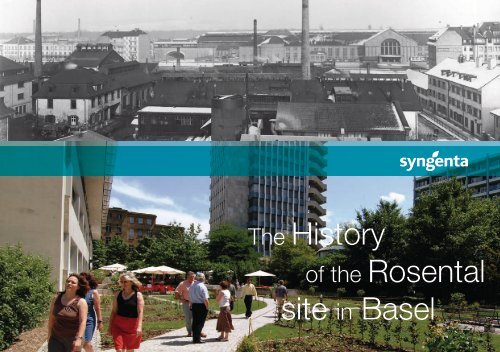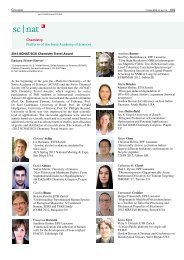The History of the Rosental site in Basel
The History of the Rosental site in Basel
The History of the Rosental site in Basel
Create successful ePaper yourself
Turn your PDF publications into a flip-book with our unique Google optimized e-Paper software.
<strong>The</strong> <strong>History</strong><br />
<strong>of</strong> <strong>the</strong> <strong>Rosental</strong><br />
<strong>site</strong> <strong>in</strong> <strong>Basel</strong>
<strong>The</strong> history <strong>of</strong> <strong>the</strong> <strong>Rosental</strong> <strong>site</strong> <strong>in</strong> <strong>Basel</strong><br />
<strong>Rosental</strong> is <strong>the</strong> <strong>site</strong> <strong>of</strong> <strong>the</strong> oldest chemical facility <strong>in</strong> <strong>Basel</strong>. When it<br />
was built <strong>in</strong> 1858, <strong>the</strong> facility was still located outside <strong>the</strong> city<br />
limits, and produced natural dyes for textiles. Over its 150-year<br />
history, <strong>the</strong> <strong>site</strong> has been transformed from a dye production center<br />
to group headquarters. Prom<strong>in</strong>ent researchers and managers have<br />
written chemical and bus<strong>in</strong>ess history on this <strong>site</strong>, with projects<br />
<strong>of</strong> <strong>in</strong>ternational importance for <strong>in</strong>dustry, medic<strong>in</strong>e and agriculture.<br />
Today, <strong>Rosental</strong> is <strong>the</strong> ma<strong>in</strong> headquarters <strong>of</strong> Syngenta, a<br />
world-lead<strong>in</strong>g agribus<strong>in</strong>ess.
<strong>The</strong> Beg<strong>in</strong>n<strong>in</strong>gs<br />
trad<strong>in</strong>g company for medic<strong>in</strong>es and related<br />
products. <strong>The</strong> company was located <strong>in</strong> <strong>the</strong><br />
“Zum Reischenberg” build<strong>in</strong>g, at what is<br />
now <strong>Basel</strong>’s Freie Strasse 42.<br />
1758 1758 Johann Rudolf Geigy founded a
1793 Geigy moved to<br />
Lichtenfelser H<strong>of</strong>, Münsterberg.<br />
1793<br />
1<br />
1 | Portrait <strong>of</strong> <strong>the</strong> Geigy family, 1758<br />
2 | Map <strong>of</strong> <strong>the</strong> Premises <strong>in</strong> 1863<br />
3 | Workforce Photo, 1896<br />
4 | Chemical extraction plant,<br />
<strong>the</strong> so-called <strong>Rosental</strong> “outer factory”, 1870<br />
1815 Hieronymus Geigy-Saras<strong>in</strong>,<br />
son <strong>of</strong> Johann Rudolf Geigy,<br />
changed <strong>the</strong> company’s name to <strong>in</strong>dicate<br />
that it traded <strong>in</strong> dyes and materials.<br />
1815
From 1830 <strong>the</strong> company<br />
produced dyes for fabric, first<br />
manually and <strong>the</strong>n <strong>in</strong>dustrially.<br />
2 3<br />
1833 <strong>The</strong> company acquired a<br />
dyewood mill <strong>in</strong> <strong>Basel</strong>’s<br />
St. Alban-Tal, where dyewoods<br />
were ground <strong>in</strong>to powder dyes.<br />
1830<br />
1833<br />
4
1860 Geigy-Merian and Heusler, a bus<strong>in</strong>ess<br />
associated with Geigy, sold <strong>the</strong> extraction plant to<br />
J. J. Müller-Pack. He proceeded to build a new<br />
factory on <strong>the</strong> former <strong>Rosental</strong> premises on<br />
Riehenr<strong>in</strong>g, known as <strong>the</strong> “<strong>in</strong>ner factory”. Syn<strong>the</strong>tic<br />
anil<strong>in</strong>e dyes were produced here for <strong>the</strong> first time.<br />
1859 <strong>The</strong> extraction plant commenced<br />
operations and produced dyes<br />
<strong>in</strong>dustrially for <strong>the</strong> first time with <strong>the</strong><br />
help <strong>of</strong> a stationary steam eng<strong>in</strong>e.<br />
1858 A new dyewood mill was built to meet<br />
modern dye production requirements. Located<br />
<strong>in</strong> front <strong>of</strong> <strong>the</strong> “Riehentor” near <strong>Rosental</strong>,<br />
it <strong>in</strong>cluded an <strong>of</strong>fice build<strong>in</strong>g and factory.<br />
<strong>The</strong> <strong>site</strong> was conveniently placed for transport<strong>in</strong>g<br />
goods via <strong>the</strong> <strong>the</strong>n relatively new tra<strong>in</strong> station.<br />
1858<br />
1859<br />
1860<br />
Initial Activities <strong>in</strong> <strong>Rosental</strong><br />
1862 Müller-Pack purchased land for a new production<br />
build<strong>in</strong>g on <strong>the</strong> <strong>Rosental</strong>matten near <strong>the</strong> tra<strong>in</strong> station.<br />
<strong>The</strong>se premises were known as <strong>the</strong> “outer factory”.<br />
1862<br />
1863<br />
1864<br />
1863 Industrial waste water polluted <strong>the</strong> local waters.<br />
1864 F<strong>in</strong>ancially overwhelmed by a lawsuit and <strong>the</strong> environmental<br />
conditions imposed by <strong>the</strong> authorities, Müller-Pack quit <strong>Basel</strong><br />
at <strong>the</strong> end <strong>of</strong> <strong>the</strong> year and left all <strong>the</strong> factory facilities to Geigy-<br />
Merian. That same year, Geigy moved its headquarters across<br />
<strong>the</strong> Rh<strong>in</strong>e from Greater <strong>Basel</strong> to <strong>the</strong> Bahnh<strong>of</strong>strasse, today’s<br />
Riehenr<strong>in</strong>g <strong>in</strong> Lesser <strong>Basel</strong>.<br />
1868<br />
1868 Geigy produced natural and syn<strong>the</strong>tic<br />
dyes <strong>in</strong> <strong>the</strong> <strong>Rosental</strong>. Geigy exported its dyes<br />
to <strong>the</strong> major centers <strong>of</strong> <strong>in</strong>ternational textile<br />
manufactur<strong>in</strong>g. In <strong>the</strong> same year, <strong>the</strong> company<br />
extended <strong>the</strong> <strong>site</strong> towards <strong>the</strong> north.<br />
1871<br />
1871 <strong>The</strong> production<br />
halls <strong>in</strong> <strong>Rosental</strong><br />
employed 66 workers.<br />
1876<br />
1876<br />
estab
5 | Traugott Sandmeyer, 1888<br />
6 | Oldest known lab photo, 1909<br />
7 | Premises <strong>in</strong> <strong>the</strong> 1920s, 1919<br />
<strong>The</strong> Sandoz dye factory was<br />
lished <strong>in</strong> <strong>Basel</strong>’s St Johann district.<br />
From 1900<br />
5 6 7<br />
Ciba (Chemical Industry <strong>Basel</strong>) was formed<br />
1884<br />
1888<br />
from <strong>the</strong> company B<strong>in</strong>dschedler & Busch.<br />
1888 Traugott Sandmeyer jo<strong>in</strong>ed Johann<br />
Rudolf Geigy & Cie. <strong>The</strong> processes he<br />
<strong>in</strong>vented contributed greatly to <strong>the</strong> company’s<br />
success. He identified <strong>the</strong> structure <strong>of</strong> a newly<br />
discovered dye for Geigy & Cie.<br />
1897<br />
1897 Natural <strong>in</strong>digo dye was imported<br />
for <strong>the</strong> last time. <strong>The</strong> manufactur<strong>in</strong>g<br />
<strong>of</strong> syn<strong>the</strong>tic dyes became a major l<strong>in</strong>e<br />
<strong>of</strong> bus<strong>in</strong>ess at Geigy.<br />
1901<br />
1901 Geigy became a<br />
public limited company<br />
and extended its<br />
premises towards <strong>the</strong><br />
Maulbeerstrasse.
8<br />
11<br />
1917 <strong>The</strong> <strong>Rosental</strong> <strong>site</strong> grew aga<strong>in</strong>,<br />
this time towards <strong>the</strong> nor<strong>the</strong>ast.<br />
1917<br />
1918<br />
1918 Representatives from Ciba,<br />
Sandoz and Geigy formed a syndicate<br />
to protect <strong>the</strong>ir jo<strong>in</strong>t positions aga<strong>in</strong>st<br />
economic competition.<br />
9 10<br />
1923<br />
1923, 1927 and 1928 New build<strong>in</strong>gs<br />
were erected on <strong>the</strong> <strong>Rosental</strong><br />
premises and some parts <strong>of</strong> <strong>the</strong><br />
production operations were moved.<br />
1935 Geigy began production <strong>of</strong> <strong>in</strong>secticides as<br />
a new bus<strong>in</strong>ess l<strong>in</strong>e, followed by fungicides,<br />
seed dress<strong>in</strong>gs and pharmaceutical products.<br />
1927<br />
1928<br />
1930<br />
From 1930 a new dye<br />
production build<strong>in</strong>g and<br />
new build<strong>in</strong>gs for<br />
adm<strong>in</strong>istrative <strong>of</strong>fices<br />
(1001) were added on<br />
Schwarzwaldallee, along<br />
with research facilities.<br />
1935
08 | Artist’s impression <strong>of</strong> <strong>Rosental</strong>, 1936<br />
09 | Picture <strong>of</strong> Memorial Plaque, 1941<br />
10 | <strong>Rosental</strong>, 1957<br />
11 | Sandmeyer Build<strong>in</strong>g, 1941<br />
discovered dichlorodiphenyltrichloroethane<br />
(DDT), which cont<strong>in</strong>ued to be used as an<br />
<strong>in</strong>secticide <strong>in</strong>to <strong>the</strong> 1970s.<br />
1941<br />
1941 A large laboratory build<strong>in</strong>g, <strong>the</strong> Sandmeyer<br />
Build<strong>in</strong>g, was erected <strong>in</strong> honor <strong>of</strong> Swiss researcher<br />
Traugott Sandmeyer (see “1888” above).<br />
<strong>The</strong> Sandmeyer Reaction is well-known <strong>in</strong> <strong>the</strong><br />
field <strong>of</strong> chemistry and did much to advance <strong>the</strong><br />
chemical <strong>in</strong>dustry. A memorial stone on <strong>the</strong> <strong>Rosental</strong><br />
premises commemorates Sandmeyer’s skills.<br />
1939 1939 Geigy researcher Paul Hermann Müller<br />
1951<br />
1951 <strong>The</strong> 1918 syndicate<br />
agreement between<br />
Ciba, Sandoz and Geigy<br />
was term<strong>in</strong>ated.<br />
1954<br />
1954 <strong>The</strong> new laboratory (1093) on Mattenstrasse<br />
was built for scientific research.<br />
1956<br />
1956 A new <strong>of</strong>fice high-rise (1002) was <strong>of</strong>ficially<br />
opened on Schwarzwaldallee <strong>in</strong> <strong>Rosental</strong>. This was<br />
one <strong>of</strong> <strong>the</strong> first high-rises to be built <strong>in</strong> <strong>Basel</strong>; three<br />
o<strong>the</strong>rs had been erected at Kannenfeldpark <strong>in</strong> 1951.<br />
<strong>The</strong> boiler house was modernized.<br />
1960<br />
Geigy shut down production<br />
operations <strong>in</strong> <strong>Rosental</strong> and<br />
from <strong>the</strong>n on manufactured<br />
only at <strong>the</strong> Schweizerhalle<br />
facility, some 10 kilometers<br />
fur<strong>the</strong>r up <strong>the</strong> Rh<strong>in</strong>e.<br />
<strong>The</strong> company demolished<br />
<strong>Rosental</strong> production build<strong>in</strong>gs<br />
and replaced <strong>the</strong>m with<br />
laboratories.
12 | Build<strong>in</strong>g 1002, 1956<br />
13 | Boiler House, 1956<br />
14 | Workplace, 1967<br />
to form Ciba-Geigy AG.<br />
1970 1970 Geigy and Ciba merged<br />
12 13 14<br />
1980<br />
1980 <strong>The</strong> experimental lab (Build<strong>in</strong>g<br />
1003) <strong>in</strong> <strong>Rosental</strong> was demolished.<br />
1984<br />
1984 <strong>The</strong> orig<strong>in</strong>al mill<strong>in</strong>g and<br />
mix<strong>in</strong>g facility (1052) was also<br />
taken down.<br />
1990<br />
1990 A new build<strong>in</strong>g (1008) was erected<br />
<strong>of</strong> <strong>the</strong> former carpenters’ workshop. Th<br />
laid out and quickly became popular w<br />
as a summer meet<strong>in</strong>g place. Swiss arti<br />
Küng’s “Golden Staircase” decorates t<br />
Adjacent to <strong>the</strong> Piazza is <strong>the</strong> “Agrogard<br />
old groundwater well, grapev<strong>in</strong>es and f<br />
Orig<strong>in</strong>ally, potatoes, corn and sunflowe<br />
planted <strong>the</strong>re. Today, Syngenta flower v<br />
predom<strong>in</strong>ate, add<strong>in</strong>g a splash <strong>of</strong> color<br />
oasis <strong>of</strong> green at <strong>the</strong> heart <strong>of</strong> <strong>the</strong> premi<br />
1996<br />
1996<br />
Nova<br />
was c<br />
head<br />
were
on <strong>the</strong> <strong>site</strong><br />
e Piazza was<br />
ith employees<br />
st René<br />
he square.<br />
en” with its<br />
ruit trees.<br />
rs were<br />
arieties<br />
to <strong>the</strong> small<br />
ses.<br />
2000 on November 13, <strong>the</strong> title to <strong>the</strong> <strong>Rosental</strong> premises was transferred to Syngenta, a new<br />
company created from <strong>the</strong> merger <strong>of</strong> Novartis Agrobus<strong>in</strong>ess and AstraZeneca Agrochemicals. <strong>Rosental</strong><br />
has been <strong>the</strong> ma<strong>in</strong> headquarters <strong>of</strong> Syngenta ever s<strong>in</strong>ce. Structural adaptations were made here <strong>in</strong><br />
<strong>the</strong> adm<strong>in</strong>istrative build<strong>in</strong>g (1001) on Schwarzwaldallee, which now houses <strong>the</strong> company’s Executive<br />
Committee. <strong>The</strong> <strong>site</strong> is also home to <strong>the</strong> global headquarters <strong>of</strong> Crop Protection and Seeds, <strong>the</strong><br />
Crop Protection headquarters for Europe, Africa and <strong>the</strong> Middle East, as well as o<strong>the</strong>r functions.<br />
In <strong>the</strong> course <strong>of</strong> <strong>the</strong> major mergers and associated sp<strong>in</strong>-<strong>of</strong>fs or creation <strong>of</strong> <strong>in</strong>dividual bus<strong>in</strong>esses, several<br />
o<strong>the</strong>r companies settled on <strong>the</strong> <strong>Rosental</strong> premises. Today <strong>the</strong>re are more than 30 companies and<br />
scientific <strong>in</strong>stitutions operat<strong>in</strong>g at this <strong>site</strong>. <strong>The</strong> great majority focus on Life Sciences.<br />
Ciba-Geigy and Sandoz merged to form<br />
rtis. <strong>The</strong> ma<strong>in</strong> <strong>of</strong>fice build<strong>in</strong>g <strong>of</strong> Ciba-Geigy<br />
ompletely renovated and became <strong>the</strong> second<br />
quarters <strong>of</strong> Novartis; <strong>the</strong> o<strong>the</strong>r headquarters<br />
located <strong>in</strong> St. Johann (formerly Sandoz).<br />
2000 Today<br />
2007 Syngenta sold large parts <strong>of</strong> <strong>the</strong> <strong>Rosental</strong> <strong>site</strong><br />
to a private <strong>in</strong>vestor and set aside a 2.5 hectare core area<br />
for its own use. At <strong>the</strong> end <strong>of</strong> <strong>the</strong> year, Syngenta moved<br />
its chemistry laboratories from <strong>Rosental</strong> to <strong>the</strong> <strong>in</strong>tegrated<br />
research center <strong>in</strong> nearby Ste<strong>in</strong> (Canton Aargau).<br />
Syngenta also opened a fitness center <strong>in</strong> <strong>Rosental</strong> to<br />
promote employee health.<br />
2007<br />
2008<br />
2008 Syngenta employs about 1200 people from some 50<br />
different nations on <strong>the</strong> <strong>Rosental</strong> <strong>site</strong>.<br />
Over <strong>the</strong> next two years, Syngenta will modernize its <strong>Basel</strong><br />
headquarters. <strong>The</strong> company will concentrate its activities <strong>in</strong><br />
<strong>the</strong> 2.5 hectare core area and run this as a separate unit<br />
to <strong>the</strong> rest <strong>of</strong> <strong>the</strong> <strong>Rosental</strong> area.<br />
15 | Golden Staircase, 1990<br />
16 | Fitness Center, 2007<br />
17 | Entrance Gate, 2008<br />
18 | Map <strong>of</strong> Today’s Premises, 2008
15 16 17<br />
18<br />
Pr<strong>in</strong>t<strong>in</strong>g <strong>in</strong>formation<br />
Publisher: Syngenta International AG,<br />
Communications Switzerland, Historical<br />
Company Archives<br />
Edited by: Noëmi Schneider<br />
Design: typo.d AG<br />
Pr<strong>in</strong>ted by: Birkhäuser + GBC AG<br />
Photos: private; Peter Schnetz<br />
Orig<strong>in</strong>al language: German with translations<br />
<strong>in</strong>to French and English<br />
Sources<br />
Report <strong>of</strong> Geotechnisches Institut<br />
Alfred Bürg<strong>in</strong>: Geschichte des<br />
Geigy-Unternehmens von 1758 bis 1939.<br />
Ciba: Aus der Entwicklungsgeschichte der<br />
Gesellschaft für Chemische Industrie <strong>in</strong> <strong>Basel</strong><br />
(Ciba). <strong>Basel</strong> 1939.<br />
Historical Company Archive <strong>of</strong> Syngenta<br />
Company Archive <strong>of</strong> Novartis<br />
Kutter, Markus: Geigy heute. <strong>Basel</strong> 1958.<br />
www.dutly.ch/sandmeier/sandmeyer.html<br />
Syngenta International AG<br />
Communications Switzerland<br />
Schwarzwaldallee 215<br />
CH-4058 <strong>Basel</strong><br />
www.syngenta.ch<br />
© December 2008



